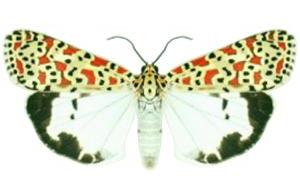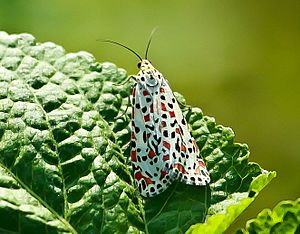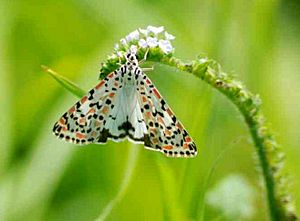Salt-and-pepper moth facts for kids
Quick facts for kids Salt-and-pepper moth |
|
|---|---|
 |
|
 |
|
| Scientific classification | |
| Synonyms | |
|
The Utetheisa lotrix, also known as the salt-and-pepper moth or crotalaria moth, is a type of moth. It belongs to the family Erebidae. A scientist named Pieter Cramer first described this moth in 1777.
You can find this moth in many warm, tropical parts of the Old World. This includes places in Africa, Asia, and Oceania.
These moths are fairly small. Their wingspan, which is the distance from one wingtip to the other, is about 30 millimeters. That's about the length of a standard paperclip!
The young moths, called larvae or caterpillars, have a special diet. They mostly eat plants from the Crotalaria family.
Types of Salt-and-Pepper Moths
Just like there can be different types of dogs, there are also different types of salt-and-pepper moths. These are called subspecies. They are slightly different versions of the same moth species.
- Utetheisa lotrix lotrix (Cramer, [1777]) – You can find this type in southern Iran, Pakistan, India, Seychelles, Sri-Lanka, China, Japan, New Guinea, Australia, and New Zealand.
- Utetheisa lotrix stigmata (Rothschild, 1910) – This subspecies lives in the Loyalty Islands, New Caledonia, New Hebrides, Fiji, Solomons, Samoa, Tonga, and Niue.
- Utetheisa lotrix lepida (Rambur, [1866]) – This type is found in Madagascar and Réunion.
- Utetheisa lotrix socotrensis (Jordan, 1939) – This subspecies lives on Socotra Island.

Images for kids
-
A salt-and-pepper moth in Kolkata, West Bengal, India.


